
Waitangi Day !
Probably the best remembered large warship of the cold war RNZN: Royalist (C89). She was a modified Dido class cruiser tailored for the needs of the RNZN but also Scotts yard envisioned to procure other customers such reconstruction and modernization, like Pakistan. Royalist was modernised at Devonport DYd in 1954-56, with her former close-range armament replaced by three twin 40mm STAAG Mk 2 automatic AA mountings (one in ‘Q’ position and two abreast the second funnel) and TT removed. The bridge was rebuilt, lattice masts replaced tripods and Mk6M directors were installed forward and aft. She became one of the most capable AA British-built cruiser ever, replacing Bellona in the RNZN fleet, but had a short career, being paid off prematurely in July 1965 and scrapped in Japan. #newzealand #waitangiday #rnzn #hmznsroyalist #didoclass #aacruiser
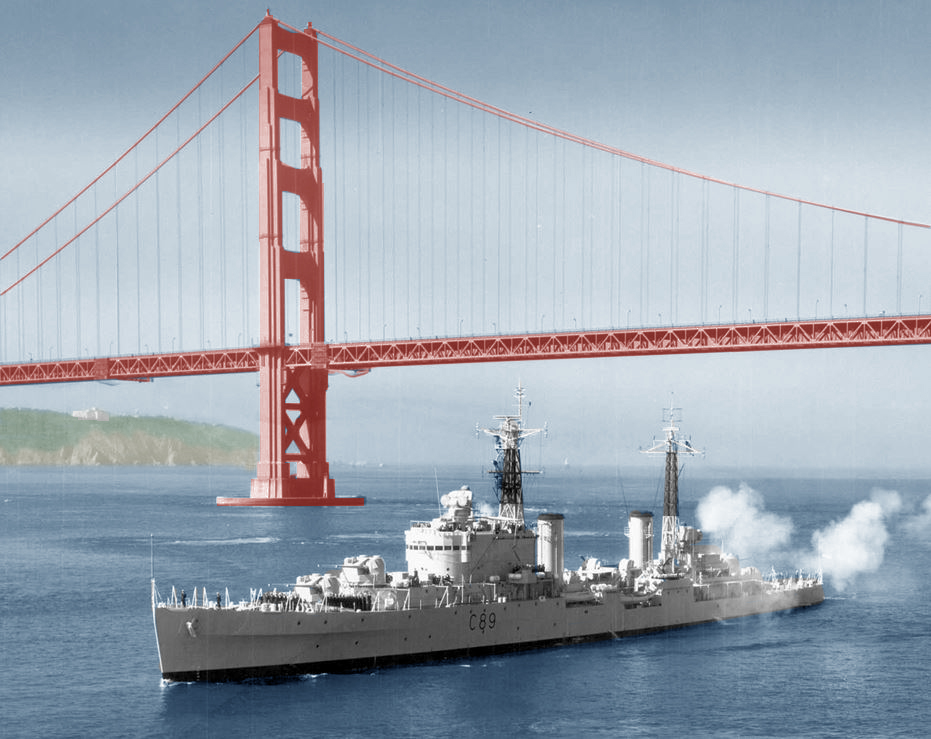
Development Story
The story of cold war Kiwi cruisers: Bellona and Black Prince
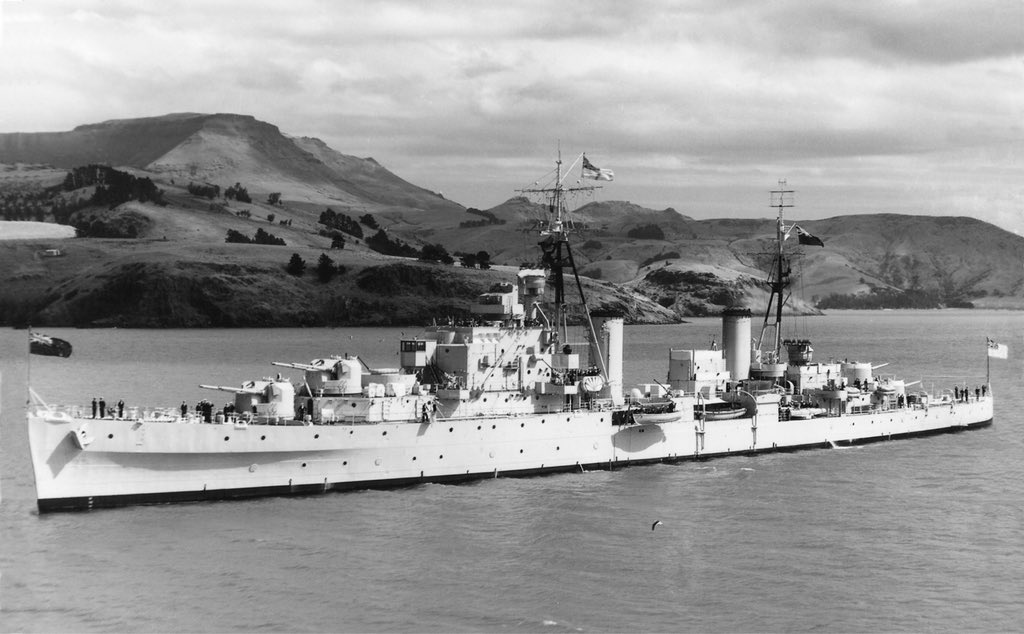
Being costly to operate, cruisers only were used for limited time: BLACK PRINCE (C 81) and BELLONA (C 63) both ex-Dido class ships launched 27.8.42 and 29.9.42 and in 1946 these two ships replaced Gambia and Achilles on loan to the RNZN. They were transferred in 1948 for an extra longer loan. HMNZS Black Prince became flagship, but Bellona was used for harbour training at Auckland. She was returned to the RN in April 1956 but Black Prince only left RNZN service in November 1961. More detailed career and modifications will be seen in a dedicated post.
A third Bellona class cruiser for New Zealand
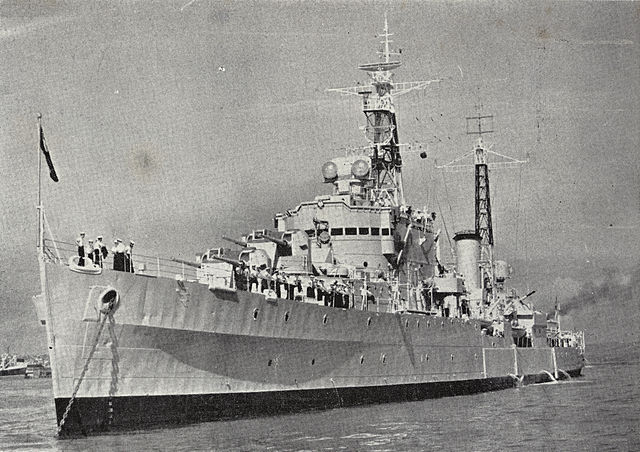
The Dido class were a prewar AA cruiser design proposed by the CNT as far as 1936. However the early batch, lead ship HMS Dido (launched 18.7.1939, completed 30.9.1940) followed by Argonaut, Bonaventure, Charybdis, Cleopatra, Euryalus, Hermione, Naiad, Phoebe, Scylla, Sirius, proved to be disappointing. Recurring issues with their main battery eventually had the decision made to create a second bath with reduced turret (four instead of five) compensated by additional light AA: The Bellona class (bellona, Black Prince, Diadem, Royalist, Spartan) which were different and improved in several ways, whereas the main issues of the main artillery was partly solved in 1943 whereas the stability issue was also solved by this curtailing of a turret and lower superstructure.
In 1945, these ships were merely exported: Three went to the Royal New Zealand Navy, but not at the same time:
-Black Prince was transferred to the RNZN in 1946,
-Bellona was transferred to the RNZN in 1948 and returned in 1956,
-Royalist was offered to NZ in 1955, and accepted, UK proposed a full modernization, completed in July 1956.
HMS Royalist was built as part of the Bellona class, a derivative of the Dido but different in many ways but their hull. Builder was Scotts Shipbuilding and Engineering Company of Greenock and she was laid down on 21 March 1940, launched on 30 May 1942 and commissioned on 10 September 1943. As built, she had four twin 133mm/50 QF Mk I as main battery, three quadruple 40mm/39 2pdr QF Mk VIII British Vickers pompom pattern, and six twin 20mm/70 Oerlikon Mk II/IV (so 12 pompom and 12 Oerlikons) and two triple 533mm or 21-in torpedo tubes banks. For sensors she had the type 272, and three type 282 firee control radars. She was cramped and not popular with her 530 crew. For her service under British flag between 1943 and 1955 see the detailed career below.
In 1946, HMS Royalist had, still, her main armament, but with three quad 40mm/39 Mk.VII Bofors, and two twin 20mm/70 Mk V, plus four single 20mm/70 Mk III as well as the type 281 radar, three type 284 fire control radars and two type 285 radars. After the war, she joined the mothballs, and stayed there pending a possible reconstruction, which was delayed again and again (see below).
It was at last confirmed in 1953 and proceeded with the intention of an interim AA cruiser to deal with the threat of new Soviet bombers sur as the TU-16 “Badger” and Myasishchev M-4 “Bison”. This was however to be the sole of the whole Dido/Bellona class to be so rebuilt under the strain of budget cuts, Churchill at the head of the new conversative cabinet, giving full priority to the RAF to face USSR.
A rocky modernization program
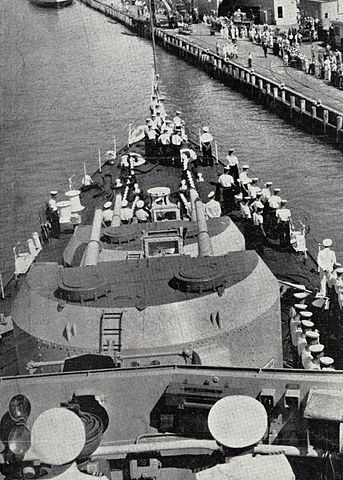 As modernized, she would have received Type 275 radar directors featuring British variants of the US Mk 37 fire control, an upgrade not adopted for the Colony-class and Swiftsure-class cruisers. Still, she kept her 5.25-inch guns, but of a modernized pattern common to the King George V battleships and HMS Vanguard. She was to have a new superstructure and advanced interim fire control to extend her active life by only six years, and cover the period of maximum danger from USSR new bombers before new missile destroyers were adopted (such as the County class).
As modernized, she would have received Type 275 radar directors featuring British variants of the US Mk 37 fire control, an upgrade not adopted for the Colony-class and Swiftsure-class cruisers. Still, she kept her 5.25-inch guns, but of a modernized pattern common to the King George V battleships and HMS Vanguard. She was to have a new superstructure and advanced interim fire control to extend her active life by only six years, and cover the period of maximum danger from USSR new bombers before new missile destroyers were adopted (such as the County class).
In March 1953, reconstruction started, with workers removing her former superstructure, to build a newer, larger, more modern and reminiscent of the one fitted on HMS Belfast. She also had new electronics, but kept part of the original armament and still her old engines. The Conservatives came to power in 1951, but they did not inflexed this plan. Churchill favoured the RAF however and by 1952 Navy Estimates were reduced. The Attlee government expansion for the Dido and Town class modernization and reconstruction were not cut back dramatically in 1952, with the Type 275 Mk 6 radar being now unavailable for the HMS Phoebe, Diadem, Cleopatra and Euryalus. It could have provided this desired long range AA capability to the 5.25 DP gun. It was not cancelled, but postponed until 1955 at best, with unused stock of earlier sets going instead to the completed new carriers HMS Eagle and Ark Royal.
Delays also marred the completion of the Tiger class cruisers and cancelled for good the modernization of Town-class HMS Liverpool and HMS Glasgow in 1952.
The only “survivor” of the budget purges after the review of June 1953 was Royalist’s modernisation, but under a revised defence White paper, in February 1954, which dediced notably the complete completion of the suspended aircraft carrier Hermes and Tiger-class cruisers. It concluded that the Dido/Bellona were ill-adapted for the new AA defence needs, and Sirius and Phoebe scheduled by the 1952 program to start in April 1954 and instead sent to scrap as even mothballing was no longer considered. Part of the decision was linked to the poorer quality steel used in wartime construction. The comprehensive modernisation of Cleopatra and Diadem (June-November 1955) was evaluated at 5-6 million pounds per cruiser and also cancelled. Soon, destroyers were preferred as well as the Type 41, Type 61 and Type 12 frigates. Another decision to stop the program for the Dido/Bellona was that they were believed to be too cramped for use as flagships or peace time RN diplomacy in the Far East.
Still, the Royalist modernization went on as it was deemed an interim sufficient to deal with the threat of newly revealed improved Tupolev Tu-4s flying at 320 mph (510 km/h) at 4.4 mi (7.1 km) height, Tupolev Tu-16 “Badger” and Myasishchev M-4 “Bison”. Since they they Flew 7 mi (11 km) high at 600 mph (970 km/h) the Royalist’s 5.25-inch shells would take 20 seconds to reach them. An updated 5.25 cruiser was this confirmed as a possible deterrent. These were more satisfying than new frigates armed with single 4.5-inch turrets.
Scott’s rebuild export package
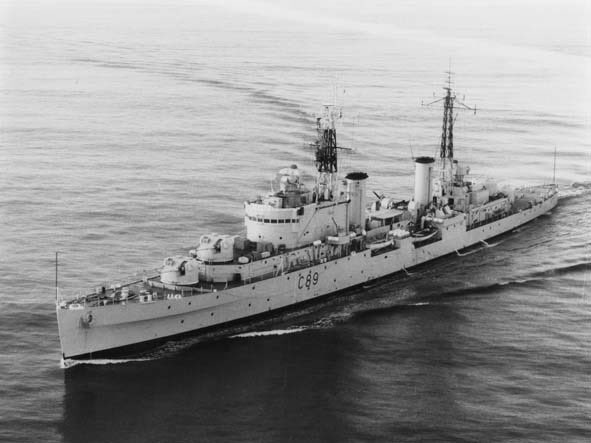
The strange occurrence was that the rebuilding of Royalist was intended also for Pakistan, which also had a Bellona class cruiser in service, the ex-HMS Diadem. She was to Pakistan on february 1956 as Babur, also partly modernized, but not on the scale of Royalist. Scott expected to sell this upgrade later.
Design of the class
Hull and general design
Royalist shared the same specs as the Bellona class as for the main hull, machinery and protection details. She displaced 5,950 tons standard and 7,200 tons full load at the start, but was rebuilt at Devonport Dyd in 1954-56 and ended a bit larger in displacement at 7,410 tonnes fully loaded instead; Dimensions did not changed, originally she was mesuring 485 ft (148 m) between perpendiculars and 512 ft (156 m) overall, and this did not changed, as the beam of 50 ft 6 in (15.39 m) although her original draught of 14 ft (4.3 m) went down to 17.7 feet, quite a large difference due to the extra displacement.
Powerplant
No change here at all. Machinery were overhauled at least (fully cleaned, all elements dismounted and inspected). It comprised the original package of four shafts, mated to four geared steam turbines, each fed by its own separate Admiralty 3-drum boiler with extensive ASW repartition for redundancy. In total this produced an output combined of 62,000 shp (46 MW).
This was enough for 32.25 knots (59.73 km/h; 37.11 mph) at least originally in 1943, but probably closer to 30 for the modernized Royalist. For range, no changed, she could cross 1,303 nmi (2,414 km) at 30 knots (56 km/h) or 3,685 nmi (6,824 km) at economic cruise speed of 16 knots (30 km/h) or 5100 km at 15 kts originally. Based on oil bunkerage of 1100 tonnes.
Armament
Main: 4×2 5.25 in (133 mm) QF DP Mark II
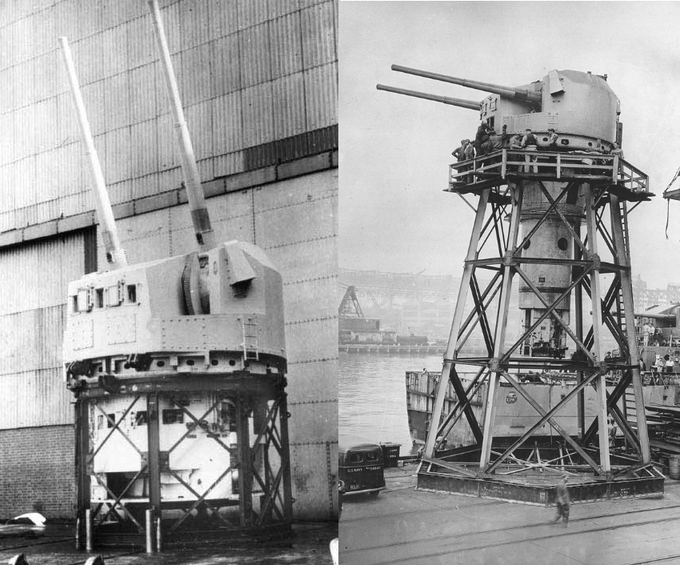
The problematic dual-purpose turrets were long in development and proved more complicated and troublesome to create compared to the US 5-in/38 twin mounts.
Specs were the same as original guns, placed in superfiring position fore and aft. The original Dido class number three superfiring turret forward was eliminated on the Bellonas and the mounted upgraded.
Barrel & breech weighted 9,616 lb (4,362 kg) for a barrel and turret lenght of 22 ft 11.5 in (7 m). These fired a 133×782 mm R separate QF, 80 pounds (36.29 kg).
Muzzle velcity was 2,672 ft/s (814 m/s). Elevation was -5 to +70 degrees with a 7-8 rpm rate of fire sustained with a range of 23,400 yd (21,400 m) at 45° (HE shell/2,600 ft/s) and up to 46,500 ft (14,200 m) in altitude for the Mark II.
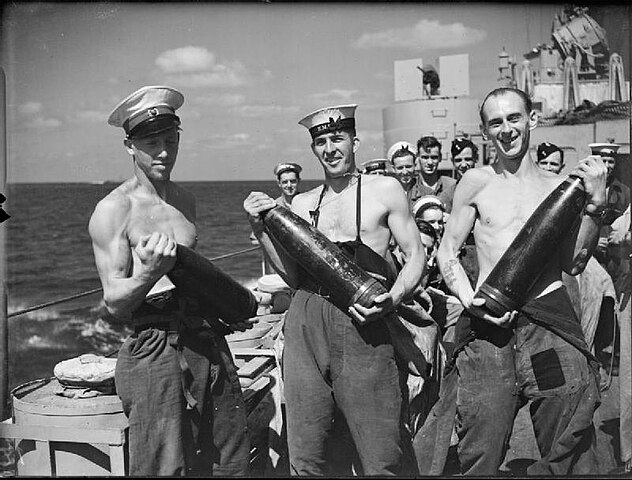
Gun crew manning 5.25 in shells aboard HMS Euryalus in 1942
Secondary: Eight 40mm STAAG Mk.2 AA
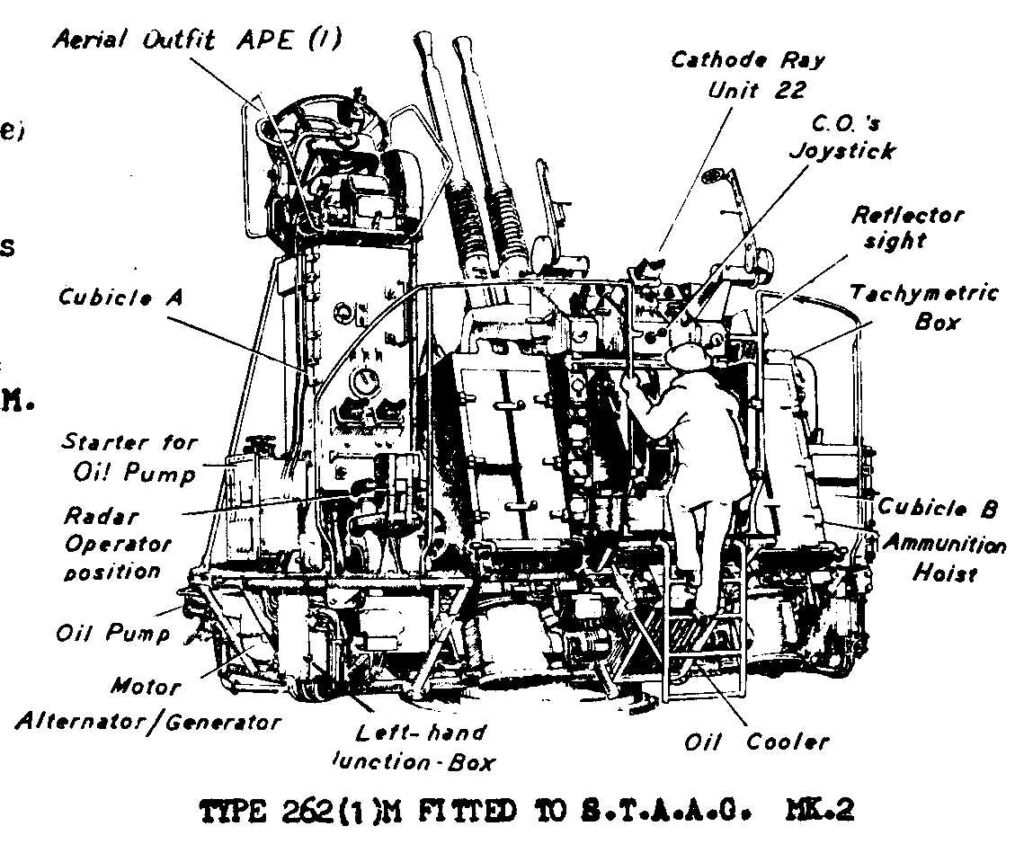
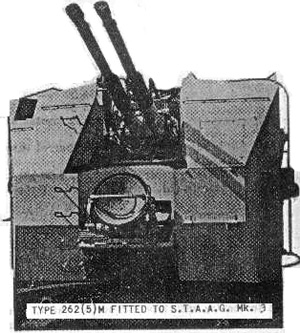 The big novelty was the adoption of a brand new pattern of British 40 mm AA mounts, a postwar evolution of WW2 systems, designed for rapid-fire at greater accuracy, and radar guidance.
The big novelty was the adoption of a brand new pattern of British 40 mm AA mounts, a postwar evolution of WW2 systems, designed for rapid-fire at greater accuracy, and radar guidance.
These were less ambitious than the six-barrels turrets developed for HMS Vanguard but were light enough for this cruiser. It was signalled by a twin mount fixed on polaform and pedestal, with the entire system protected by a multi-faceted shield. The barrels were quite close together and fire was thus not simultaneous but alternated, which was nearly impossible to hear as the rate of fire was considerable.
18 ton mounts, Gun Bore was 1.57 in, rate Of Fire 240 rpm, max range ported to 10,180 m. These had an Integral Director and were Power Operated.
Projectile Mass was 21,2 kgs (warhead 0.9 kgs), muzzle velocity 881 m/s. In all 21 systems were designed, notably adopted, apart Royalist, by HMS Hawke and HMS Daring destroyers.
However according to Navweaps, this Mark II twin mounting Mark 2 with type 262 radar was very accurate but also very unreliable. The radar dish antenna was indeed mounted directly to the gun mount, exposing it much vibration. This system was a light artillery also with a very heavy mount at 17.5 tons. It used the Mark X gun, hydraulically powered. It wa scalled a “pseudo-triaxial” mounting with third axis having lateral deflection instead of cross-roll. Training and elevating speeds: 35°/sec. In the end, an overly complicated system, maintenance heavy, for a short service life. As for accuracy, the radar was able to track even the tow wire of any distant tow plane and direct fire to cut it each time.
Distribution of the AA aboard was three SPAAG Mk.II twin mounts, two either broadside between funnels, and one aft, behind and above the second main turret. The two single Bofors hhad simpler mounts, but shields, and latest barrels; They were installed on either side of the bridge. Needless to say as the ship was scheduled to be a modern AA cruisers, the two TT banks were removed, which also helped with tonnage sparing and stability.
Protection
It was unchanged. Figures are the following:
Belt: 3 in (76 mm),
Deck: 1 in (25 mm),
Magazines: 2 in (51 mm)
Bulkheads: 1 in (25 mm)
Sensors
Originally, all radars had been upgraded, and now consisted in two Mark VI directors for and aft, whereas tripods were rebuilt in derricks to support heavier radars in the future.
These were the type 281 main 350 kW–1 MW aerial warning radar (FRQ 86–94 MHz PRF 50ps Bdt 35° Pwt 2–3 μs/15 μs Range 115 nmi alt 30,000 feet (9,100 m)
There were also three small type 282 (dish liked) fitted on the AA guns mounts. 600 MHz (UHF-band), pearl power 25 kW range 3.5 nm (≙ 6.5 km)
Type 284 radar: See full history
Two type 285 radars: 25KW Anti-aircraft FCS/gunnery radar (600 MHz bwt 18°/43° pwt 2 μs RA 18,000 yd (16,000 m) Alt 15,000 ft (4,600 m) prc 150 yd (140 m))
Type 960/277Q radar: The latest installed, in 1955, replacing the Type 281. 450 kW, worked at 86-90 MHz in VHF-ban. PRF 250 Hz pwt 5-15 µs RA 175 NM bwt 35°, revolutions 7 min⁻¹
For the main guns, this cruiser had the best AA suite of any RN ship, with two Mark VI directors for her 5.25″ guns assisted by the new Flyplane computer system. Also as seen, the light Bofors AA were radar-assisted also with the Type 262 radar placed on the three gun mounts.
But above all, the ship had the new “full Action Information Organisation”, meaning an internal room used as general battle system for coordination not only of onboard wepaonry, but also able to coordinate fellow airplanes and ships, while taking track of opponent’s assets in real time. It was the 1950s British AEGIS.
⚙ specifications |
|
| Displacement | 5,950 tonnes standard, 7,410 tonnes fully loaded |
| Dimensions | 485/512 ft oa x 50 ft 6 inx 17 ft 11 in |
| Propulsion | 4 shafts Parsons SGT, 4 adm. 3-drum boilers, 62,000 shp |
| Speed | 32 kts |
| Range | 1100 t oil., 5100 nm/15 kts |
| Armament | 4×2 5.25 in/50, 3×2, 2×3 40mm STAAG Mk.2 AA. |
| Protection | 3-in belt, 1 in bulkheads |
| Sensors | Type 960/277Q radar, see notes |
| Crew | 450 |
The short career of HMNZS Royalist
Before the transfer: HMS Royalist in 1943-1955
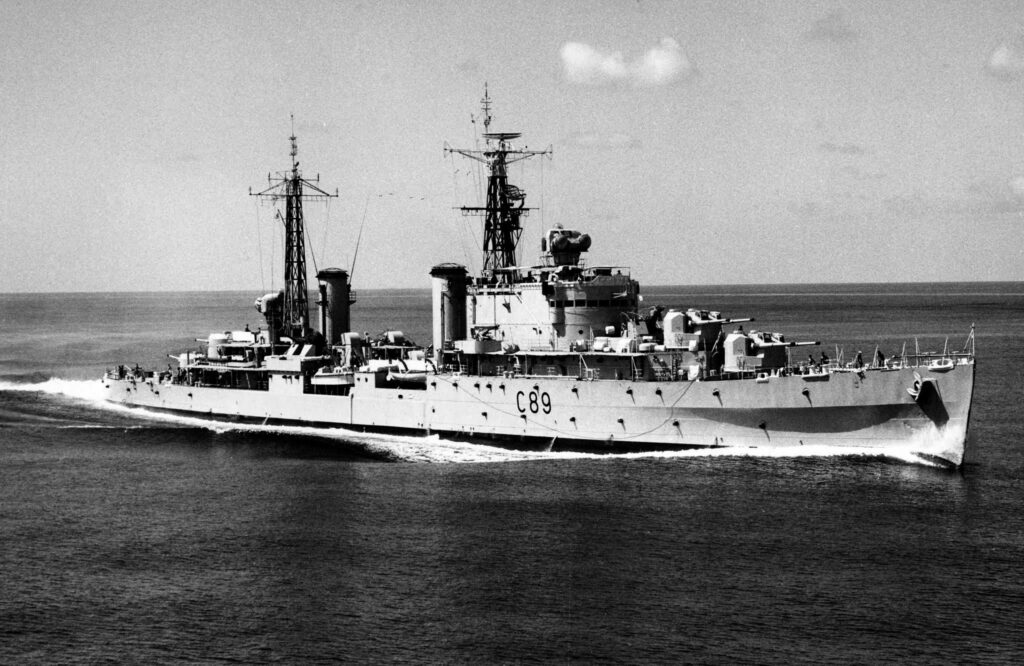
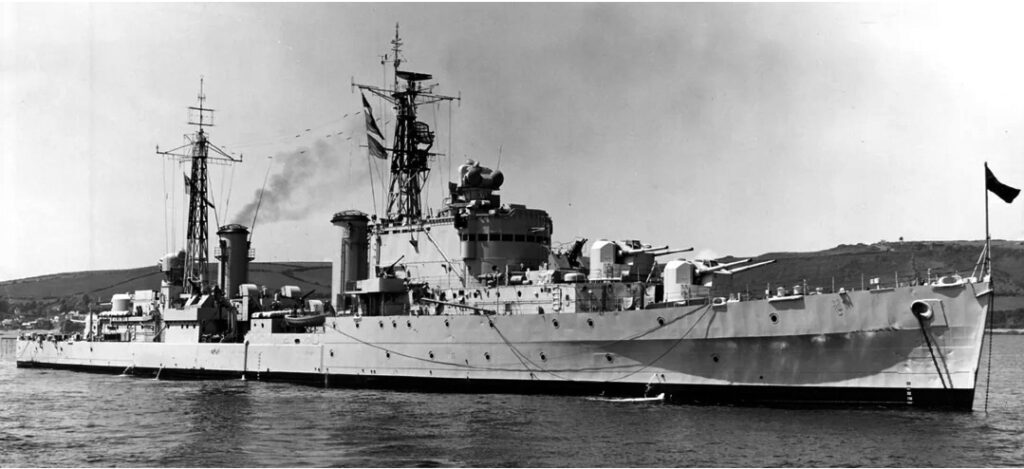
After commission, HMS Royalist spent months in training, ironing out issues, and underwent post-trial fixes and alterations, additions. Notably she was turned into a carrier flagship. By March 1944 HMS Royalist joined the Home Fleet and for long, escorted vessels to the Arctic theatre (Murmansk convoys). She took part in Operation Tungsten, carrier raid of April 1944 on Tirpitz in Norway and acted as flagship for Rear Admiral Arthur La Touche Bisset, Force 2 (five carriers).
After these she resumed escort of carriers this time to raid german-held shipping off Norway. Next she had a drydock refit completed in June, and was assigned to the Mediterranean for Operation Dragoon, the landings in the south of France, by August. There again, she was flagship, Rear Admiral Thomas Hope Troubridge, mixed Task Force 88 (TG88.1and TG88.2 carried groups) providing air superiority over the area and during inland operations.
Afterwards, HMS Royalist joined the Aegean Force trying to hunt down German vessels evacuating these islands. On 15 September she was escorted by the destroyer HMS Teazer when spotting and sinking the KT4 and KT26 off Cape Spatha. She stayed in the area until late 1944 and had a refit in Alexandria by early 1945 before being reassigned to the East Indies and Eastern Fleet.
In April 1945 she joined the 21st Aircraft Carrier Squadron as flagship again, for Operation Dracula (Rangoon landings). From 10 May she took part in Operation Mitre a group of carriers looking for Japanese warships evacuatiing troops from the area of Nicobar-Andaman and until September 1945, she covered these carrier raids in the East Indies and Sumatra.
She returned home and was mothballed, dehumidified in 1946 for long term reserve.
Modernisation of four Dido-class cruisers was decided and it included Royalist as approved by the Admiralty board, on 30 March 1950, confirmed in 6 April 1950 for her in particular. She was to be the first Bellona-class modernised under this programme, with wotk scheduled to start by January 1953. This was targeted to the RNZN after Black Prince and Bellona which replaced the larger Gambia in 1946 for reasons of fuel and manpower and under more realistic timescale and budget.
As HMNZS Royalist
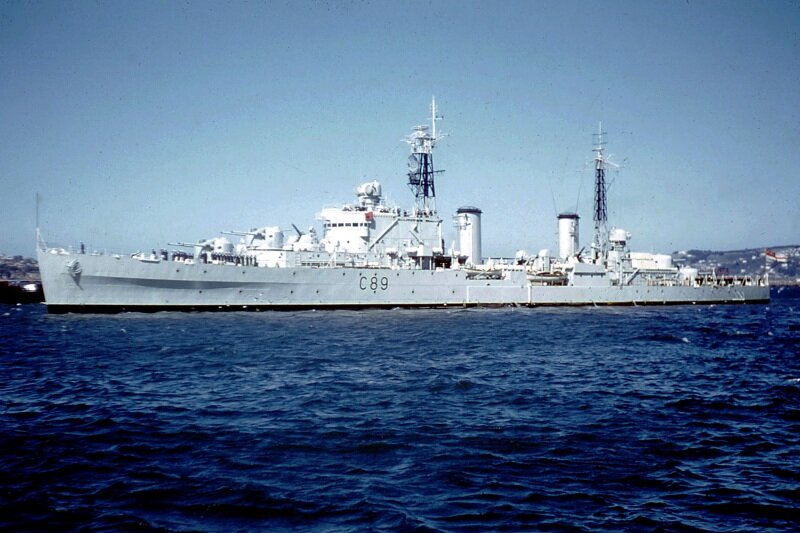
A Difficult Acceptation
New Zealand PM Sid Holland accept the offer of Royalist in February 1955 as she was no longer needed as an interim towards Soviet bombers. But when it happened, her reconstruction was only half completed after 3 million pounds spent and New Zealand agreed to pay £4.5 million to complete it. So by early 1955 Holland concluded the agreement after a 7-week visit to the US, also meeting VP Richard Nixon, secretary of state John Foster Dulles and Churchill. He preferred the cruiser to the proposal of frigates to the defense East of Suez for escort duties. Churchill at the time thought a brief exchange of thermonuclear weapons would make ASW frigate irrelevant for convoys. PM Harold Macmillan also urged to refocus NZ defence on the Pacific, on shorter lines of communication and forget about the Middle East. They all argued that Royalist completed by 2-3 ASW frigates would be perfect and an order was reserved for Type 12 frigates, although still untested and unproven at the time. It was suggested later to wait for new frigates better suitable to NZ conditions.
Still at home, the decision to finance the completion of Royalist was criticized, as the £4.5 million was equivalent to the cost of two new 2,500-ton frigates. Many thought it was better for the RNZN to maintain six frigates in good training conditions plus commonality rather to adopt an AA cruiser such as a Royalist, better apropriate as a fleet escort againt very little change of attacks by Soviet bombers. In the end, massive assistance from the RN and US Navy the cruiser went into her post-refit, which lasted a staggering 9.5 years. After the crisis of Suez in 1956, the Royal Navy transferred the largest part of the fleet in the Indian and Pacific Oceans until 1967 and requested Royalist to be deployed with the RN carrier fleet as escort.
Shhe was finally handed over on 9 July 1956, with Captain Phipps in command. He was no favourable t the deal in the first place, as was diplomat Frank Corner which believed this ship was a white elephant unsuitable for the Pacific. Still many in the navy appreciated the services offered by the Bellona and Black Prince, albeit range was limited. The cruiser for example could not reach Panama. Later however Phipps was inerviewed by local medias of Auckland and stated the cruiser was “updated as a most modern warship in the world” with its capability to take “three targets simultaneously and shoot down air targets with reasonable frequency often on the first salvo”
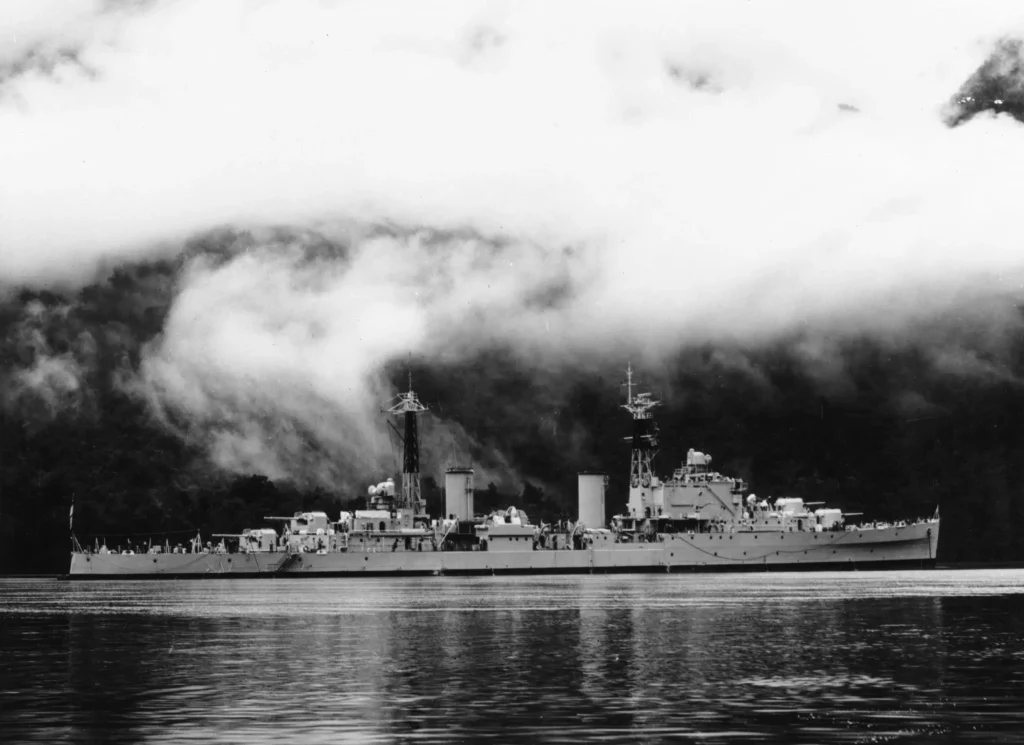
HMNZS in Milford Sound
The New Zealand Navy Board eventually accepted the RN view that the RNZN needed a cruiser in the South Pacific for RAN/RN operations. For them it was a powerful interim medium-range AA platform. Royalist was also still seen as a RN cruiser on loan, as the RN still saw the RNZN as more strongly integrated in the RN unlike the independent RAN and RCN at the time. Camptain Phipps saw the accomodations were still of WW2 stock and machinery quite old, demanded some improvements, which were refused on 6 April 1956. It was accepted in service formally with the minimum of adjustments with just four additional showers, officers’ baths removed and ventilation improvements.
Another critic, proper to new cold war conditions, was that Royalist was not NBC protected. Sealing was only partial, there was no pre-wetting, no ABC spraydown equipment, despite it was requested by the RNZN in 1955. Devonport developed it but suggested the main New Zealand dockyard could intstall it. Royalist lack of comfort also in part came from the fact she had beds only for 47 officers, while ratings still had hammocks. The usual extra room with sofa for senior rates (mess) was sacrificed for extra communications systems and the famous Action Information Office (AIO) created late 1943.
In the following year, Phipps complained still on living conditions, recruitment, and ammunition supply while asking for new frigates. In the admiralty some argued that Royalist could join an RAN task force centered on Melbourne and Sydney and that her AA suite could give some deterrence to Sverdlov cruisers. Plus she could escort escort convoys the whole distance at 19 knots (35 km/h; 22 mph) whereas Type 12 frigates could only go from Fiji to Hawaii at 10-15 knots. Officers maintained her role for trade defence against Soviet cruisers and raiders was still relevant to the ANZAC in the new nuclear war context looming.
The Suez Crisis
At the start of her service, around 25% of officers on Royalist were RN officers on loan or exchange, as many specialist ratings. RNZN officers were of junior experience, reflecting the sentiment she was “on loan”. She first worked out in UK waters, and started her operational carrer in the Mediterranean. By 1956, NZ PM Sidney Holland was asked by Anthony Eden to keep Royalist on station for ‘strategic deployment’/’deterrent’ facing Egyptian or Israeli threats. The shipwas lock in the strategy also under persuasion by the First Sea Lord /CnS Lord Mountbatten plus the First Lord of the Admiralty, Lord Hailsham, regulary arguining she was the “best RN cruiser” available in the Mediterranean. The NZ Cabinet supported in the end Suez Crisis invasion, later denounced by PM Marshall and MoD MacDonald.
They came to order Royalist to withdraw and set sail for home, but it was still seen as too damaging for morale and future relations with Britain. She was eventually allowed to remain on station but not participate in any action, knowing she could be engaged at any moment against the Egyptian air force. Her captain saw her as a picket and rescue ship, also offering aircraft direction and assisted passing by RAF English Electric Canberra bombers as well as carrier Sea Hawk and Sea Venom. Her long-range air warning Type 960/277Q radar proved up to the task. She could provide aircraft direction to the other cruisers and destroyers in the task force as well.

After hostilities commenced, Commonwealth support shifted to New Zealand and Australia, and soon International opposition and Holland had a hard time to defend at home a “stand by the UK” position while the goovernment at was in majority willing to not damage New Zealand’s relationship with the US. Eisenhower saw the operation embarrassing before a reelection while the USSR just invaded Hungary. Later there were tense exchanges between the Foreign Office, Royalist, and NZ Foreign Service officers. Eventually Cpt Phipps was ordered to withdraw the cruiser helped by Holland’s failing health. As the operation was still going on, the RN saw as replacement only the less capable HMS Jamaica adn so the Royalist was ordered back to keep station 40 nm off the Egyptian coast as emergency picket. She directed the first Sea Hawk strikes from HMS Eagle, Bulwark and Albion, to Cairo. In the latter, recce spotted 63 MiGs and 49 Ilyushin Il-28 “Beagle” in nearby airfields. Camberra strikes were directed from Malta and Cyprus but failed to cause any damage on 31 November.
Royalist remained on station for 24 hours more as picket and rescue ship, assisited by radio fighter bombers to target and back to carriers until HMS Ceylon replaced hem, back to shore bombardment duty off Port Said. When the threat of Egyptian aviation was eliminated, Royalist withdrew from the main body of the RN fleet but stayed as primary air warning and communications vessel. Holland then officially ordered the withdrawal but allowed a stay until the conclusion of Operation Musketeer anyway. RN officials menawhiled pleaded with Phipps to remain as long as the Egyptian Air Force remained a threat. Aboard the ship a good portion of the crew, RN career officers and rating specialists agreed. Eventually the ship stayed and departed at the end of operations, Phipps arguing the crew being deserved a recognition for their involvement in this operation, but vets had to wait until the 2000s to be awarded personnel battle honours “Mediterranean”. It seems that her cruiser’s log for the time was destroyed.
Operations in Malaya
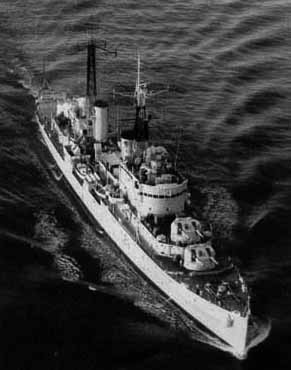 In early 1957 Royalist was in exercizes with aircraft carrier HMAS Melbourne and made two shore bombardment missions in 1957–1958 for the Malayan Emergency targeting insurgentts in southeast Johore, and spending some 240 5.25-inch rounds. In AA exercises she won the Far East Fleet Town-class cruisers. She managed to shoot down five Gloster Meteor targets and many towed targets.
In early 1957 Royalist was in exercizes with aircraft carrier HMAS Melbourne and made two shore bombardment missions in 1957–1958 for the Malayan Emergency targeting insurgentts in southeast Johore, and spending some 240 5.25-inch rounds. In AA exercises she won the Far East Fleet Town-class cruisers. She managed to shoot down five Gloster Meteor targets and many towed targets.
In 1960 Royalist underwent a major five-month refit to serve another two and a half years only. the New Zealand navy board wanted instead a Whitby-class frigate (Type 12) while the RN argued the Rothesay-class (Type 12M) would be more effective to replace a cruiser. By February 1964 HMAS Voyager collided with Melbourne and sank, and saw UK offered the Daring-class destroyers, Duchess and Defender with their new MRS3 fire control instead. Eventually it was decided that Defender would replace Royalist from February 1965.
In 1962, Royalist was caught in rough weather in the Tasman Sea, and her keel twisted out of alignment. Under a RAN captain, it seems she sailed at excess speed into a head sea and it was concluded she had her back broken and could be even considered as a mild (not total) ‘constructive loss’, thus uneconomic to repair or modernized. The milalignment of the hull meant notably the gun directors would fail to determine the centreline necessary for accurate targeting.
Despite of this, she was maintained in service with British Far East Fleet, making operations of 1963, 1964 and 1965, and taking part also in the Indonesia–Malaysia confrontation with some in the crew awarded General Service Medals and much later in 2000 Operational Service Medals retroactively for their 1956, 1957–1958 and 1965 service years by the new labour government.
By mid-1963, the captain reported his two Mk 6/275 HALADCTs were unreliable while the two STAAGs were just too difficult to operate due to heavy maintenance, as still innacurate. Frequent maintenance and re-painting of the lower structure was led to the recruitment of an extra Asian workforce as the low-quality wartime steel tended to absorb more paint and needed more care overall. After tyhe 1962 hull damage, below-deck humidity augmented while internal cooling was found inadequate, with constant 85 °F (29 °C) temperature at the lowest, and way over depending on external conditions. So much heat was accumulated below decks that the crews in exterme cases had to take tours to operate and sleep on deck by night.
A new modernisation plan was to provided for six years, but by May 1964 the Indonesian Confrontation escalated. British Mod Peter Thorneycroft and Mountbatten requested a show of force to encourage a revolt against Sukarno and after R&R in Singapore, Royalist took full fuel oil provision and foord reserve, then ammunition to depart on 15 July 1964, returning to Auckland and transited the Carmat Straits on 15 July and posted herself in the Java Sea, between Jakarta and southwest Kalimantan, then the Lombok Strait on 17 July 1964, two transits of the straits for the benefit of HMS Victorious, with guns were fully manned, crews closed up in case of agressive Indonesian aircraft passages. The worst secnario in an escalation would have been annattack with long-range air-launched Kh-20 (“Kangaroo”) cruise missile from Indonesia TU-16 bombers.
She was in a task force led by Victorious by September 1964, escorted by County-class HMS Hampshire, frigates HMS Dido and HMS Berwick. After this, the RNZN staff doubted Royalist, not refitted since 1956, could deploy in 1965 and she just made a seven-week refit in Devonport before returning home at Hauraki Gulf, still reacing 27 knots at half power. The question of modernizing her fire control systems was evaluated to 12 months refit for $140,000 and if not, will leave only the two STAAG serviceable, since the UA3 ESM were unreliable. It was expected the steam turbines would worrk for 15 months for a final goodwill and fareweel visit to NZ ports in 1966;
End of Service
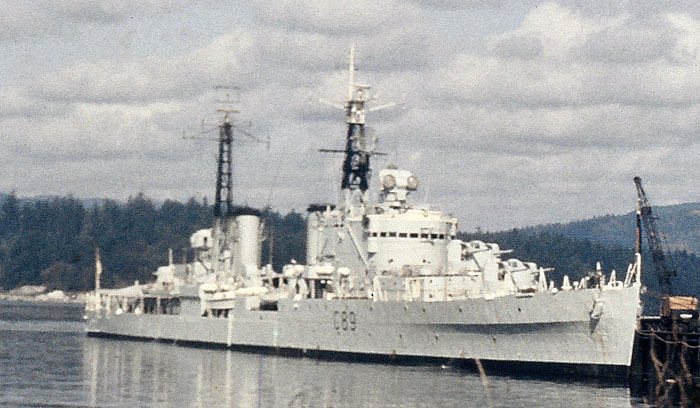
The decision to retire Royalist was seen as a catastrophy since by the British Far East Fleet staff, as it was overstretched during the confrontation, whith a carrier that could provide nuclear deterrence to Jakarta and adverse nuclear strike in return dependent of a naval presence, with the Tiger-class cruisers too maintenance heavy, HMS Lion withdrawn after a boiler explosion, HMS Blake put into reserve due to crew shortages. Saw HMS Royalist was still needed in Singapore, notably to escort the amphibious carriers HMS Albion and HMS Bulwark. It was asked that she sailed to Pearl Harbor for a second workup, not a longer refit in Devonport ands return to Hong Kong and Singapore.
Royalist sauled indeed to Pearl Harbor where she was cared for by USN staff and dockyard workers provided efficient to cure her issues and make adjustments to her fire control system. She even achieved “E Excellent” for Efficiency during workup and sailed back to Singapore in 1965, to start an anti-infiltration campaign, boarding boats and sendinf shore patrols, while taking part in Exercise Guardrail to simulate a Sverdlov cruiser attack (like the one possessed by Indonesia at the time INS Irian) while providing gunfire support and air defence support to the benefit of HMS Bulwark off Borneo. The crew were awarded Operational Service Medals.
She was asked to sail to Yokohama for Royal visit by Princess Alexandra to Japan, but RNZN sailors and under captain of Royalist, J.P. Vallant were found not welcome. They had R&R in Bangkok, Singapore, Subic Bay, before returning to New Zealand, after valiant of a milking boiler and turbine bu her general condition was such her final 1966 visit for Waitangi Day and tour of New Zealand was cancelled; She was paid off five months early on 4 June 1966 so for 11 years of service in the RNZN, and reverted to RN control in 1967 as still unofficially on loan. Bu unable to sail here, she was sold for scrap and towed to Nissho Co, Japan, by November 1967, makin her last trip from Auckland to Osaka on 31 December 1967.
Read More/Src
Books
Conway’s all the world’s fighting ships 1947-94
Links
on navymuseum.co.nz/
on .comrades.co.nz/
on shipspotting.com/
on facebook.com/
on worldnavalships.com/
wikipedia.org/
navypedia.org bellona.htm
rnzncomms.org
Videos



 Latest Facebook Entry -
Latest Facebook Entry -  X(Tweeter) Naval Encyclopedia's deck archive
X(Tweeter) Naval Encyclopedia's deck archive Instagram (@navalencyc)
Instagram (@navalencyc)





 Austrian Navy
Austrian Navy French Navy
French Navy Royal Navy
Royal Navy Armada Espanola
Armada Espanola K.u.K. Kriegsmarine
K.u.K. Kriegsmarine Dansk Marine
Dansk Marine Nautiko Hellenon
Nautiko Hellenon Koninklije Marine 1870
Koninklije Marine 1870 Marinha do Brasil
Marinha do Brasil Osmanlı Donanması
Osmanlı Donanması Marina Do Peru
Marina Do Peru Marinha do Portugal
Marinha do Portugal Regia Marina 1870
Regia Marina 1870 Nihhon Kaigun 1870
Nihhon Kaigun 1870 Preußische Marine 1870
Preußische Marine 1870 Russkiy Flot 1870
Russkiy Flot 1870 Svenska marinen
Svenska marinen Søværnet
Søværnet Union Navy
Union Navy Confederate Navy
Confederate Navy Armada de Argentina
Armada de Argentina Imperial Chinese Navy
Imperial Chinese Navy Marinha do Portugal
Marinha do Portugal Mexico
Mexico Kaiserliche Marine
Kaiserliche Marine 1898 US Navy
1898 US Navy Russkiy Flot
Russkiy Flot French Naval Aviation
French Naval Aviation Russian Naval Aviation
Russian Naval Aviation Sovietskiy Flot
Sovietskiy Flot Royal Canadian Navy
Royal Canadian Navy Royal Australian Navy
Royal Australian Navy RNZN Fleet
RNZN Fleet Chinese Navy 1937
Chinese Navy 1937 Kriegsmarine
Kriegsmarine Chilean Navy
Chilean Navy Danish Navy
Danish Navy Finnish Navy
Finnish Navy Hellenic Navy
Hellenic Navy Polish Navy
Polish Navy Romanian Navy
Romanian Navy Turkish Navy
Turkish Navy Royal Yugoslav Navy
Royal Yugoslav Navy Royal Thai Navy
Royal Thai Navy Minor Navies
Minor Navies Albania
Albania Austria
Austria Belgium
Belgium Columbia
Columbia Costa Rica
Costa Rica Cuba
Cuba Czechoslovakia
Czechoslovakia Dominican Republic
Dominican Republic Haiti
Haiti Hungary
Hungary Honduras
Honduras Estonia
Estonia Iceland
Iceland Eire
Eire Equador
Equador Iran
Iran Iraq
Iraq Latvia
Latvia Liberia
Liberia Lithuania
Lithuania Mandchukuo
Mandchukuo Morocco
Morocco Nicaragua
Nicaragua Persia
Persia San Salvador
San Salvador Sarawak
Sarawak Uruguay
Uruguay Venezuela
Venezuela Zanzibar
Zanzibar Warsaw Pact Navies
Warsaw Pact Navies Bulgaria
Bulgaria Hungary
Hungary

 Bundesmarine
Bundesmarine Dutch Navy
Dutch Navy Hellenic Navy
Hellenic Navy Marina Militare
Marina Militare Taiwanese Navy
Taiwanese Navy Chinese Navy
Chinese Navy Indian Navy
Indian Navy Indonesian Navy
Indonesian Navy JMSDF
JMSDF North Korean Navy
North Korean Navy Philippines Navy
Philippines Navy ROKN
ROKN IDF Navy
IDF Navy Royal New Zealand Navy
Royal New Zealand Navy Egyptian Navy
Egyptian Navy South African Navy
South African Navy

































 RN
RN
 Marine Nationale
Marine Nationale
 Soviet Navy
Soviet Navy
 dbodesign
dbodesign